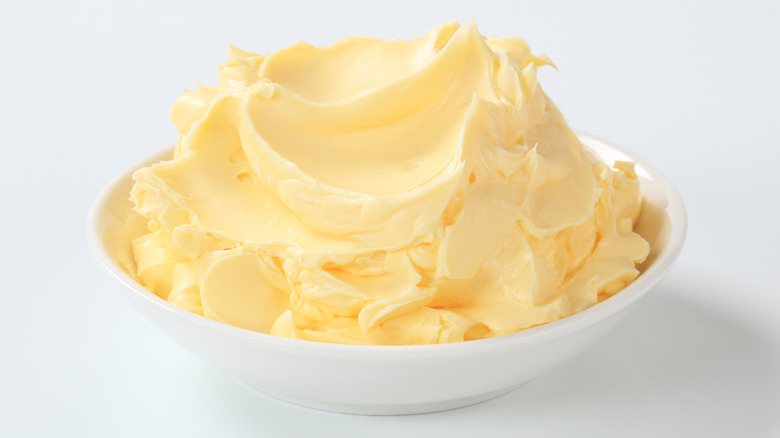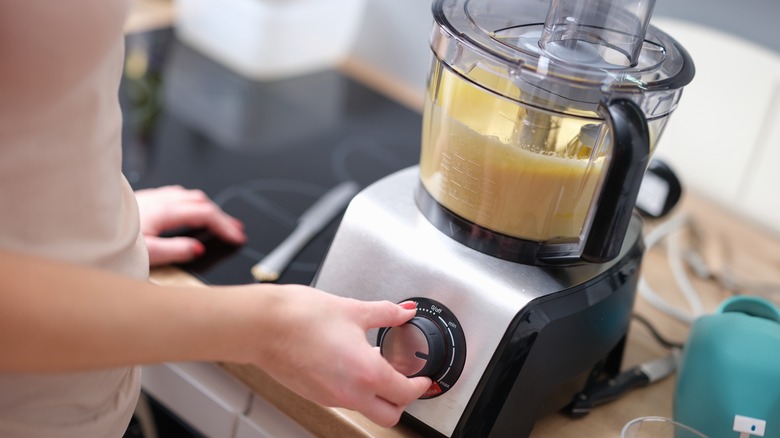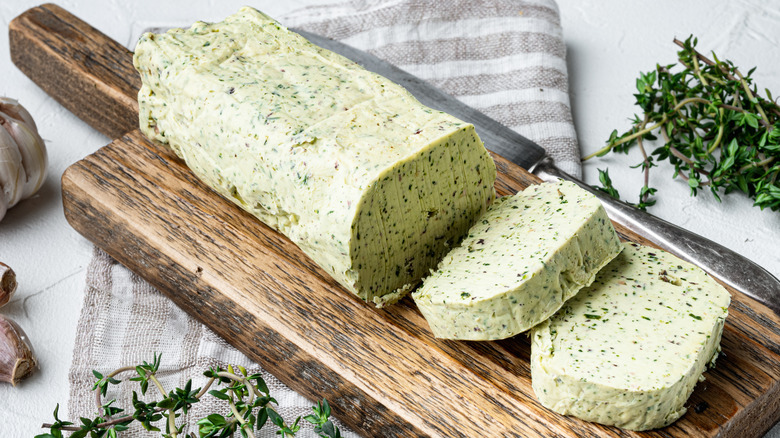Your Food Processor Is The Key To Effortless Homemade Butter
What comes to mind when thinking of making butter might be the image of a person working diligently at a wooden churn for hours to produce a large amount of the stuff. And while that may be how it was traditionally done, there is an easier way to make homemade butter: By using a food processor.
The science behind making butter is rather fascinating. Exploratorium explains the process as "transforming a fat-in-water emulsion (milk) to a water-in-fat emulsion (butter)." Cream, where the fat content of milk resides, is separated from whole milk and then agitated so that the fat molecules clump together to create a solid mass. The key word here is "agitate" — in fact, you may have accidentally made the beginnings of butter when over-whipping cream, as the breaking of the cream is actually the fat clumping together. To simply and intentionally make butter, place cream in a food processor and let it run until the solids and liquids separate. Remove the solids, form it into a pat, and you have butter! So, let's get into the details of this process.
How is butter made?
The first step to making butter from scratch is to procure the highest quality cream. The better the cream, the better the butter, as it is the main (and often only) ingredient. Pour this cream into a food processor and whizz it for at least three minutes. The cream will gradually separate during the processing; stop the machine when chunks of butter form. Strain the butter solids from the liquid into separate bowls. This liquid is buttermilk, so keep it for another use (it can last in the fridge for up to two weeks).
Add ½ cup of ice water to the butter solids and stir them together using a large spoon or spatula. Drain off the water and add another ½ cup of ice water, stirring and draining again. This process "rinses" the butter solids, so continue until the water is clear. Continue either by hand or with the food processor. If using the food processor, wipe out the bowl and blades, return the rinsed butter solids to the bowl, and process until they form a ball. Then place this lump of butter in a cheesecloth or clean dish towel and wring out as much liquid as you can. This helps it last longer and improves its texture. Place the butter into a container, then store it in the fridge for up to three weeks or nine months in the freezer.
Ways to amp up homemade butter
If you would like to flavor your homemade butter to make compound butter, there are endless options to choose from. Whatever flavoring you decide, this step should be added to the butter and kneaded until evenly distributed before forming the stick.
The classic flavor is, of course, regular salted butter, and for the amount of butter above, about half a teaspoon will suffice. Beyond that, there is a wealth of flavored butter recipes to explore. Adding several cloves of roast garlic will give you instant garlic bread when spread on toast. A tablespoon of finely chopped fresh herbs kneaded into the butter makes it a perfect companion to a homemade steak. Or flavor the butter with a teaspoon of ready-made spice mix like Old Bay as an easy way to upgrade a sandwich.
If you would like to go in a sweet direction, mix in one teaspoon of sugar instead for a straightforward sweet hit. Feeling fancy? Consider adding a few tablespoons of berries with a pinch of warm spices like cinnamon and nutmeg to invoke instant pie vibes, or a tablespoon of citrus with a touch of honey to add a sweet zing to your breakfast.


